Every day player expectations are raised, and what might be popular when you start development can be a bygone fad once your product hits store shelves. Simply put, gaming is a scary industry to invest in.
Capcom is no stranger to this fact. Originally, they’d publish numerous titles with a shorter development time, smaller budgets and a smaller return of investment. For example during the 6th generation of consoles they published around 152 games. Meanwhile, on the Playstation 3, 4 and 5 combined, they published a combined total of 140 games (excluding re-releases like HD collections).
Their focus has clearly shifted away from numerous releases, to casting a wide net instead. No longer do they release more than twenty action games per generation like on the Playstation 2, instead it’s a single new game on the Playstation 4. Resulting in less unique and experimental games like Under the Skin, Zack & Wiki, Shadow of Rome or Dark Void.
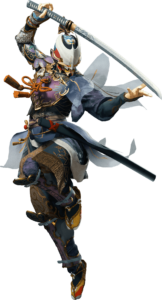
In such a world, Kunitsu-Gami: Path of the Goddess, published by Capcom July 2024 on modern and last-generation hardware, is an oddity to say the least. A new franchise, without a setup for support through microtransactions and DLC. A risk.
It is directed by Shuichi Kawata, who previously helmed Capcom’s lesser known Shinsekai: Into the Depths for Apple Arcade in 2019. Shinsekai was known for its atmospheric underwater exploration, mixing memorable visuals and sound design with tense, but simple, resource management.
The design of Kunitsu-Gami seems similarly simple from the outset. You control Soh, a spirit summoned by the divine maiden Yoshiro. Every stage you must guide her to the level’s gate where she will purge the stage of the corruption that dwells within. During the day you purify animals for healing items, cleanse corruptions for crystals and save villagers to help you repair obstructions and later-on fight alongside you when night falls. This is all set in beautifully designed areas reminiscent of old Bunraku puppet theatre.
Kawata noted that he “wanted people to feel like they are playing the game while looking into a diorama”, helped by its more zoomed out camera, use of pre-recorded practical effects and that each object in the game was sculpted by hand before being digitised.




The aforementioned crystals are your main resource, being needed to carve a path for Yoshiro to reach the gate, while also needed in increasing amounts to assign helpless villagers a fighting-class. These classes range from a simple melee class, the typical tank and healer archetypes, to more off-beat classes like summoners and cannoneers.
Soh himself is not helpless though; a warrior with all the familiar tools we’ve come to expect of action games, old and new. A block, dodge, the typical XXY dial-a-combos and later on also a bow, perfect parry and screen-clearing super moves. It’s all there.
That said, the main appeal of the game’s combat is directing your squad of villagers, who are easily given orders with a press of a shoulder-button, to prepare for the waves of enemies coming at nighttime.
Stages start off simple, offering a linear path and only one door from which the demons come crawling, but slowly introduce new elements. Some take place in the dark, forcing you to light lanterns to see enemies from afar, while others have a branching path, lack villagers to support you, have toxic pools, take place on a boat or have multiple points from which you are assailed.
Each stage also has pre-set traps that you can spend time to repair, rewarding some foresight from where enemies will come from and to allow you some wiggle room in your defensive strategy. Assigning one villager the sumo-wrestling tank role should cover the front-line, then you to the side and the flank covered by traps; that makes an excellent plan.
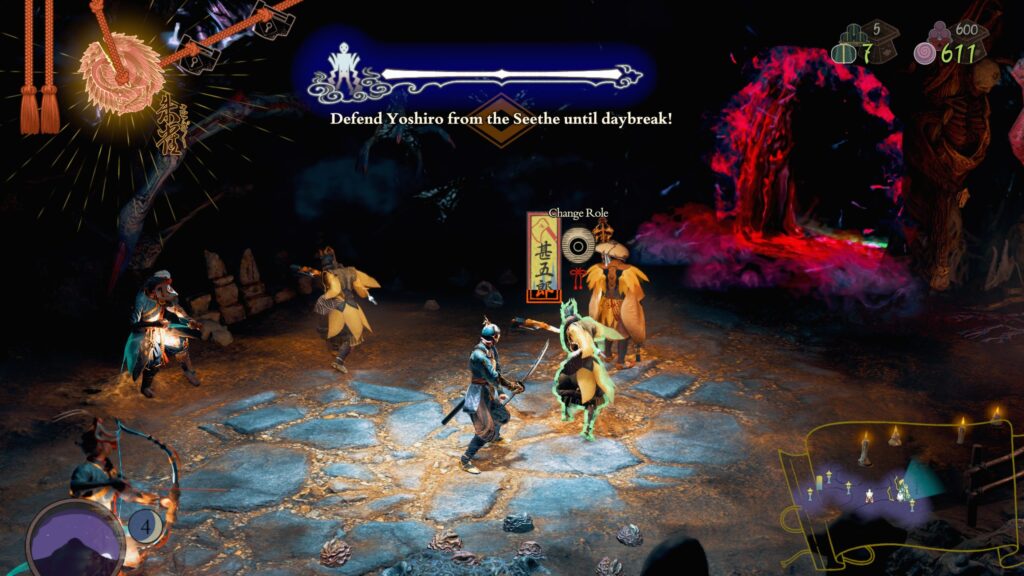
Note Yoshiro’s healthbar at the top, and healing item and crystals at the top-right.
How the stage plays out depends on how you handle your economy of crystals. You can carve a path to the end, and have Yoshiro dance towards the gate as far as she’ll go before the sun goes down. This will allow you to beat the stage faster, but she’ll be out in the open, making the fight at night more difficult.
You can also play slower by putting her in safer spots with more cover, forcing you to survive for more days but at less risk. This slower play allows for more crystals to be used to turn your villagers into stronger classes, while rushing sees you be low on resources – it’s a nice balance, one that is sadly hampered by the fact that you can farm crystals to some extent by replaying other stages beforehand.
To increase difficulty, without bothering newcomers still coming to grips with its unique take on the genre, each level also has optional challenges. These vary by stage, going from mundane tasks like breaking all the pots, to beating the cavern mission without lighting any lanterns, doing a no-damage run or even doing it solo; rewarding you with extra upgrade-points to give you and your villagers new abilities or slight stat-boosts.
Even with these additions though, Soh’s moveset isn’t that complex. Though guard-cancelling speeds up a few attacks, it’s nothing groundbreaking. And while your villagers’ roles each have their unique quirks with ups and downs, they offer little in gameplay method. Complexity and depth, so far, seem at a minimum.
Instead it comes more from the enemies. They come in all sorts and sizes, with over twenty unique types, with little to no overlap in their function. There’s the typical fodder enemy that comes en-mass in hopes of overrunning your defences, enemies that give their followers a speed buff, demons that disable lanterns, larger than life sweepers, monsters that will try to possess your villagers, snipers, ranged artillery that shoot poison bombs to behemoths that transform into giant staircases to circumvent your walls and much, much, much more. All while each has a strong silhouette and design, making them easy to identify despite the zoomed-out camera. Below is just a small sample of the game’s wide array of enemies.
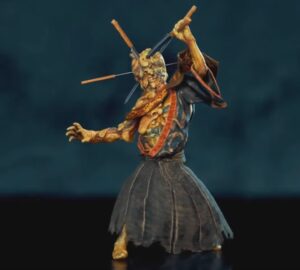
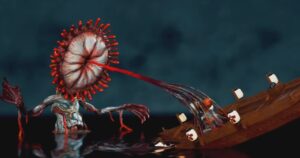
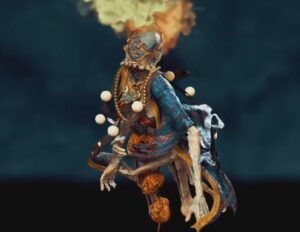
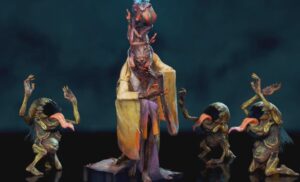
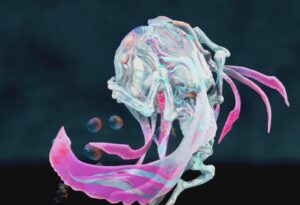
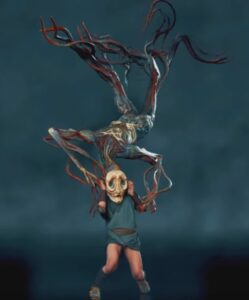
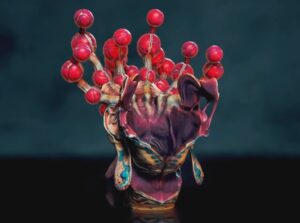
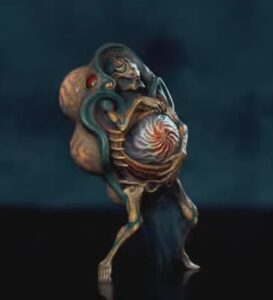
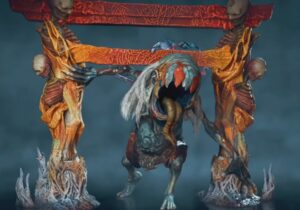
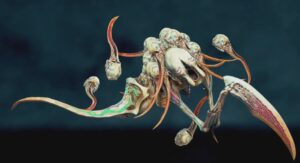
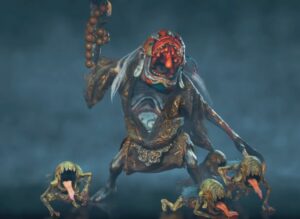
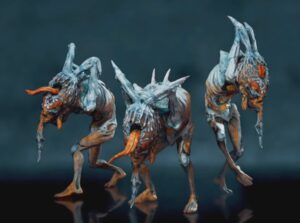
These enemies, their constant intermixing and the unique positions they’re put in relative to your valued maiden, but also in terms of the game’s verticality, make each wave feel unique and satisfying to conquer, despite the buttons you press being simple and without much timing. It’s more about where you go, who you fight, when and with what. This is further helped by the more open-ended defensive options. Since fights are large in size, with big complex landscapes as their battlefield, positioning is often already enough to avoid enemy-attacks; parrying and dodge are more of a bonus feature here.
With that in mind, the stagger system can feel somewhat out of place. Once Soh gains specific upgrades, each enemy will have a small stamina-bar that can be drained using charged attacks. Once depleted these enemies become dizzy for a moment, allowing you to wail on them or do a special finishing move for high damage; laying waste to once dangerous and durable foes. In a game with such great variety in enemies, offering the player a simple one-size-fits all solution, is an ill fit.
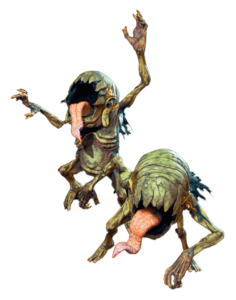
Should you still fail however, death is not the end. Instead Soh will become a spirit and still be able to issue orders; only when Yoshiro dies is it truly the end. After enough time has passed Soh is resurrected. Time, in general, is a key aspect of the game. Soh heals over time and his Tsuba special moves also operate on a cooldown. While cooldowns usually result in players using them as fast as possible in hopes of activating them multiple times during a fight, but in Kunitsu-Gami, since it’s a game about surviving the night, players will use them much more strategically. And while some are the aforementioned screen-clearing moves, others are built differently. For example there’s a dance that gives villagers hyper-armour for a while and another that grants them an attack boost. The most interesting is Kochin’s Ward, which pops a bubbleshield at your location, offering a lot of utility; being able to shut down an avenue of attack, protecting Yoshiro from artillery or force a boss to walk around it; buying you precious time.
Because the game does have boss-fights, usually after each stage. Most of them operate as a regular enemy with a twist, and being able to summon allies, forcing you to constantly switch between defensive and offensive. They generally also have a weakness, for example the giant worm Mukadejoro can be stunned when you light all the lanterns in his arena. Still, these fights are more appetisers than the main course, and when you reach the end-game they become nothing but a triviality to your levelled villagers and your wide array of Tsuba special moves. Something the game acknowledges as most bosses have an optional challenge of beating them in around 90 seconds.
This is because, throughout the game, you’ll collect optional perks to equip to further enhance or personalise your playstyle, alongside with upgrading your abilities with new tools like a bow-shot that slows enemies, to the aforementioned perfect parry and even an entirely new moveset. The perks, called Mazo Talismans, sport over eighty different variations. With only 5 being equippable at the same time, they offer a variety of combinations and can help you fill in the blanks in your playstyle. From making Soh stronger, boosting your villagers at the cost of your own potency, make repairs go faster, having you die in a single hit or disable your healing – from added to reduced challenge, it’s all possible.
Once you start to realise specific combinations and rank up Soh and his villagers, encounters will start to go by extremely fast. Scouring the community’s request for features to be added in a potential patch, the highest requested one seems to be able to fast forward during the nighttime, as the waves die too fast, forcing players to wait for sometimes a minute on end; a harsh indicator of the low-difficulty once upgrades start piling up.
This lack of the game scaling with you never goes away, even New Game Plus’s remixed enemy waves never manages to catch up. Once dangerous giants die in two charged attacks or are decimated by a swarm of ninjas at your command. There is a satisfaction to it, but also a lack of it, especially when stages are played one after another in longer sessions the repetition of an enemy appearing only to die immediately sinks in fast.
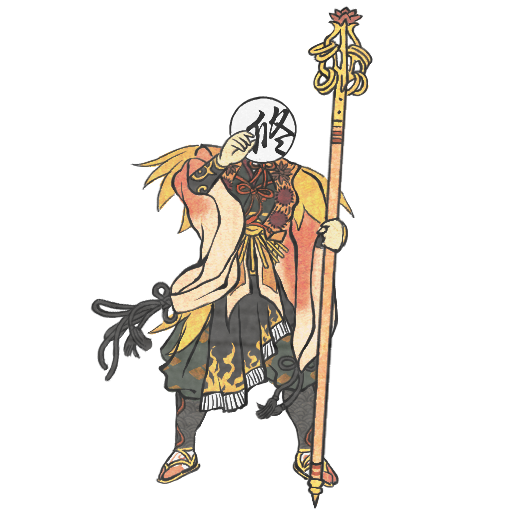
Certain classes and combinations also feel wholly overtuned. The Aesthetic class, when fully upgraded, will slow enemies in an aura while also giving them a defensive debuff and damaging them over time. Meanwhile the lowly Priest needs to do a lengthy incantation to remove enchantments-buffs from enemies, which rarely happens anyway, and can remove toxic pools, which rarely appear- these could’ve been mixed more instead of one-size fits all.
The Aesthetic when paired with a Sumo tank and one ranged support can easily hold off an entire spawn point. And while the game attempts to balance these classes with higher costs, with melee Woodcutters only being 50 crystals compared to a Sumo’s 250, since crystals carry over between stages, can be farmed and are given in large quantities, this rarely becomes an issue. Had crystals been more rare, and a set resource in the stage itself as opposed to a perpetual one, it might’ve offered more balance, but as it stands it doesn’t.
This aversion to difficulty and risk is felt in the game’s stages as well. When it feels like the game has finished introducing all its unique mechanics and enemies, one would expect the game to then fully open up and start combining them. Stages with elevators and lights, multiple branching paths and flanking enemies while a demon tries to possess Yoshiro – the possibilities are endless. Instead when this moment is reached, the game throws a boss-rush at you before rolling the credits. And while the aforementioned New Game Plus tries to add some challenge, with added optional challenges as well as a hidden superboss, the game is begging for challenge-maps or a survival mode where the title really gets to play with all its toys. In a sense, the title is a risk, but didn’t take enough within it.
Interestingly though, this might have been intentional. In an early interview director Kawata and producer Hirabayashi noted that it was never the point for the game to be difficult to understand, and wanted players to “be able to customise their strategies and upgrade them from their experiences of the past stages. But we don’t want users to solely use strategy, we wanted to have the right balance”. Perhaps they didn’t want players to be too challenged in this new formula, and more have the right experience. Regardless, a higher difficulty would’ve been fine for New Game + or a Hard Mode for players that wanted to seek it out.
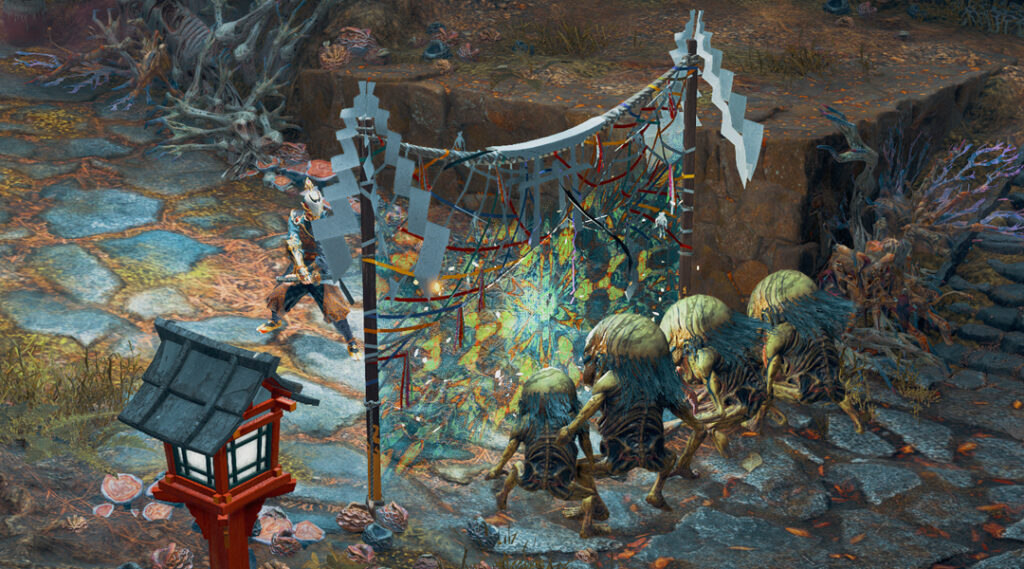
This mentality is doubly interesting when confronted with the game’s unlocks, which seem to urge multiple completions. Currently it even offers unique in-game rewards for beating numerous NG+ cycles, going as far as giving you a unique costume for beating the game eight times on one save-file.
During one such runthrough, you might decide to disable all your upgrades for the genre famous “no upgrade run” to see if it might give the game some of its initial bite back from when the game first started. No Upgrade Runs tend to force players to rely more on the game’s basics, trimming the fat. In some games this leads to a frustrating experience with low-damage output and hour-long boss fights. In others it elevates the game to new heights.
Kunitsu-Gami is without a doubt the latter, to the point where it might even become the way to play when players have gotten comfortable with its mechanics. Once easily cleared waves become scrambles of survival and easily made choices in village-roles are now more complex as no class offers multiple solutions anymore. Since the stagger system is mostly absent without upgrades, large demonic now require kiting and focus-fire to take down, all while focussing on your drained flank which cannot hold off the engagement much longer without Soh’s help.
Suddenly all the game’s pieces once again come together to a grand whole, with you truly fighting to survive and hold out against all odds, while bosses once again become a dangerous back and forth engagement instead of the ten seconds of special-attack animations they were before.
That is not to say that with upgrades the game is bad, but it sincerely lacks the bite in the long run to stay engaging. Ironically Kunitsu-Gami could benefit from the modern approach of DLC and expansions to give the game’s mechanics a chance to truly shine when all its moving parts are used in unison. Because they are there. Even then though, we’re still left with a unique and refreshing game in a genre steeped in one-on-one combat and stamina-bars. For that alone it should be recommended, and commended. It was definitely a risk worth taking.
鑒 reflection style 鑒
In this short section I reflect on the article from my own viewpoints as a gamer and lover of the genre instead of a critic.
I want to start by saying: thank you for reading. Stinger-Magazine is still a big part of me as a person, and something I’m very proud to have set up and have readers for. Since the birth of my (beautiful) daughter last December, most of my personal projects have gone on hold and game-time has been at a very minimum. As such, it was unique for a new game to grip me as Kunitsu-Gami did, as I had mostly stuck to the familiar games that I knew where to go and how to play in the few hours a week that I could relax.
In a sense I feel it’s a game that benefits greatly from a more limited playtime, as I can imagine playing it in long sittings can become very ‘samey’, regardless of its quality.
With the niceties out of the way, I am going to be a tad harsh for a second, and I apologise beforehand. Kunitsu-Gami recently celebrated its 500.000th sale with some in-game goodies. In a world where we’re begging for new titles in the genre, and are rage-playing titles like Wukong, Resident Evil 3 Remake and Stellar Blade just for a glimpse of something as good as what we got 15 years ago, I feel this is also a testament that players don’t vote with their wallet. Yes, there’s no physical release, but even then… I always hear talk about wanting more unique PS2-era action titles that take risks and try new and interesting things. Yet when this game comes out I see it be met with “ looks interesting, maybe later“. You have to put your money where your mouth is, which maybe feels unfair but needs to be said. If you’re on this site, like its content and want to play more unique action games, I highly suggest setting aside some of your hard earned money and enjoying this game instead of whatever else is flooding the market. It deserves it. If only to also communicate to Capcom that we, as players, are open to more unique and interesting titles.
斬 postscript notes 斬
- The game featured bonus costumes for those that pre-ordered, but it should be noted that these are unlocked also upon beating the game normally;
- Capcom collaborated with Ningyo-Joruri Bunraku Theater’s Master Kanjuro Kiritake III to direct a bunraku prequel to the game. Titled Ceremony of the Deity: The Maiden’s Destiny, it was released on YouTube on July 18, 2024. The idea came from game director Shuichi Kawata, a fan of bunraku, and Master Kanjuro agreed to help plan the project despite initial hesitation;
- Some mention should go to the fantastic user-interface, at times sacrificing legibility for just having it fit the game’s aesthetic so much. From your health-bar being a banner, to every item having unique illustrated icons to the upgrade screen being fully animated – it’s a joy to behold.
- The game also features a lot of little details that are easily missed. You can feed Yoshiro specific sweets during the game for example, each with unique eating animations. And all villagers have a day and night cycle when you revisit their towns after they’ve been cleansed, with their own jobs, responsibilities and even beds to sleep in.
- Director Kawata did not work on Okami, but producer Yoshiaki Hirabayashi was involved in the HD remake of the game. Both love and respect the original Okami, hence the inclusion of some of its music and costumes as an unlockable feature;
- Though not the subject of this article, it should be noted that Shinsekai was delisted from Apple Arcade. Had the game not gotten a Switch port years later, it would’ve become vaporware. Showcasing the importance of game-preservation once again;

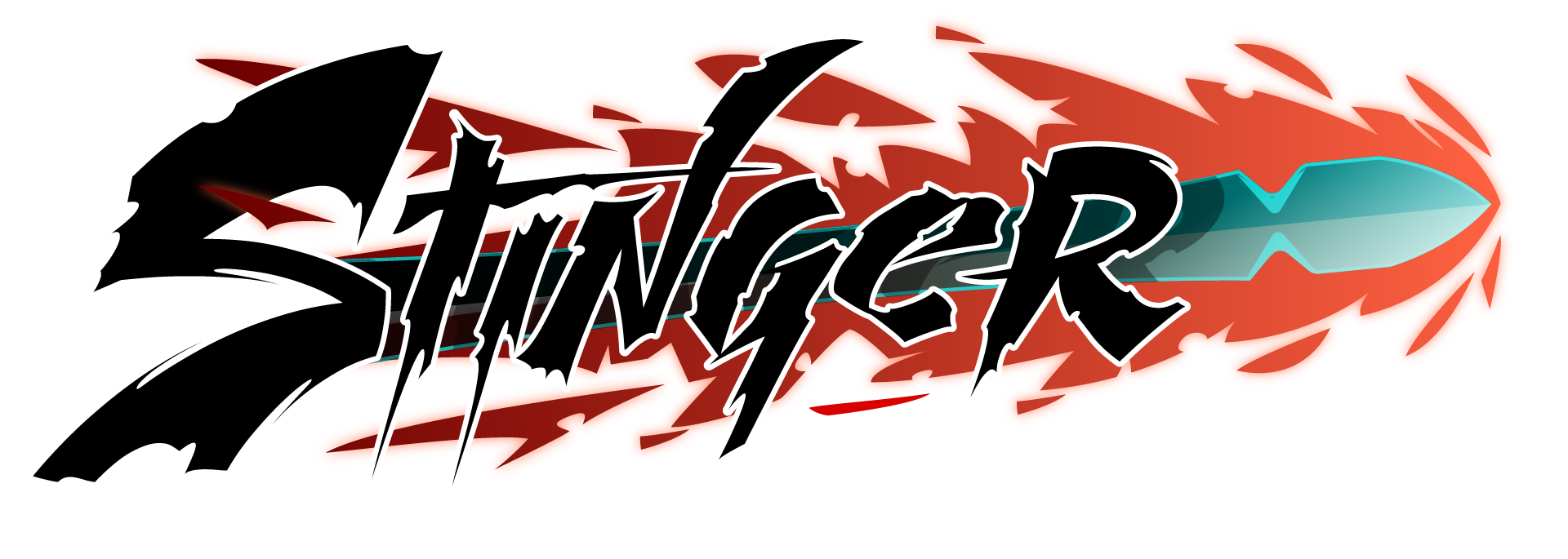












“Yet when this game comes out I see it be met with ” looks interesting, maybe later”. You have to put your money where your mouth is, which maybe feels unfair but needs to be said.”
At the same time, when an ostensibly positive review says the game has to be played in small doses to avoid being repetitive and needs an NUR to avoid becoming comically imbalanced, it might explain why the game is in “rainy day” territory for so many possible players.
That is a bit cynical isn’t it. I doubt that’s the reason though, since reviews (both professional and fanbased) do not note the low difficulty or imbalance (in fact, most note a high difficulty), let alone NuR.
Thanks for putting my thoughts into words and doing it beautifully. I do love this game and I’ll continue replaying it but, even when I try to challenge myself with the handicap upgrades, it honestly feels too easy. Things die too quickly and I wish I didn’t have to forego my upgrades to bring back that sense of difficulty. Ah well, it’s a great game regardless! Nice article!
Appreciate the kind words, glad you enjoy the title as well! I think it definitely shines as note, really curious if it will be expanded upon in the future with DLC or a sequel that irons out the difficulty-issues.
This is probably my game of the year. It does work best in sessions of 2 or 3 levels in a sitting, but that’s not a bad thing. I’m also playing Fire Emblem atm and it is the same thing. People forgot what is like to play a stage-based instead of an open world of infinite distraction and time-wasting.
Most definitely. Considering my personal situation (fatherhood), I’m finding stage-based games to be far more enjoyable since it has a set start and endpoint that I can grip on to. Also feels generally a lot less wasteful in terms of time.
It’s a good game, I certainly like it, and I hope more games like it come along.
If they don’t, I’ll just make one myself. Been learning Godot…
So, your comment convinced me to give the demo a try. I see why some people say it’s challenging, but that challenge comes from entirely stupid things — namely, the fact that you can’t zoom the camera out. This means positioning villagers is a pain (you can’t see where one currently is when you order him to a new location), and you can’t actually see where the angles of attack actually will be until you get the “omg, the chick is getting hit!” message by which point it’s too late to do anything. On the other hand, the actual action is just brainlessly hitting XXY, or XY if there are flying enemies around.
I don’t think this game doing poorly has anything to do with gamers not being open to games that take risks. It has to do with it being a rather lame game.
You can zoom out (right on dpad by default), there’s also a map-overview (select, pauses the game as well so you can see where everyone (including enemies) are). Pressing the order-menu also zooms out more.
You can see where one currently is (map) and the one you select is highlighted in visual mode (yellow outline). Angles of attack are also highlighed on the map (spawn points).
Think it has more to do with yourself at this point and you trying desperately to do your name justice.